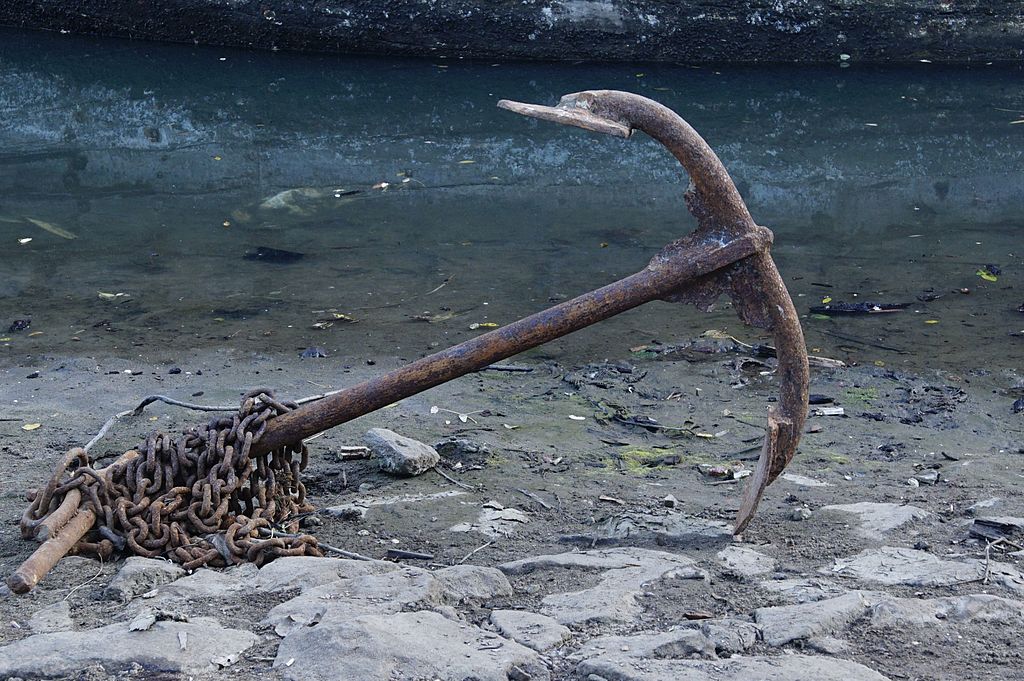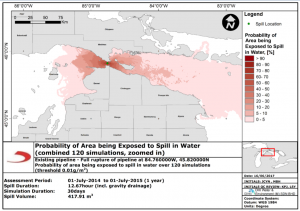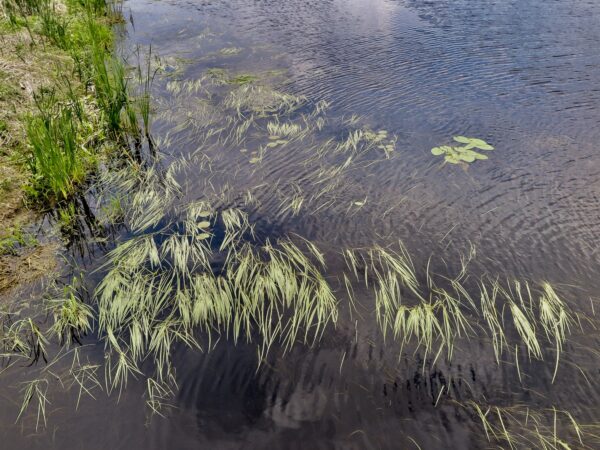
It isn’t corrosion that poses the biggest threat to Enbridge’s Line 5 pipeline. It’s the possibility a large ship could drop its anchor and puncture the pipeline. The line was built in 1953 and carries 23 million gallons of oil a day under the Straits of Mackinac.
Another revelation: The Line 5 pipeline has a 1 in 60 chance of breaking by the year 2053.
Those are the conclusions of Dynamic Risk Assessment Engineers who spent 2 hours detailing their analysis at a meeting in Holt, Michigan.
Chief Engineer at the company contracted to create the report, Dynamic Risk’s James Mihell said, “The threat is that we can get a pipeline lodged in between the flukes and the shank. And you can’t stop an 80, 000-ton cargo vessel with a 20-inch pipeline.”
The 1000-page report on alternatives to the Line 5 pipeline is one of two studies the State of Michigan contracted to help gather information on what action to take for the future of the Enbridge-owned pipeline. Enbridge agreed to pay $3.26 million to subsidize the studies. The other report, which was a risk assessment of an oil spill in the Straits, was thrown out due to conflict of interest concerns because one of the researchers was allegedly working for Enbridge while contributing to the report.
This new report released at the beginning of July looked at several alternatives for the future of Line 5, the pipeline that runs from Superior, Wisconsin to Sarnia, Ontario through Michigan’s Upper and Lower Peninsula and splits into two smaller lines under the straits.
One of the alternatives – a total shut-down (“abandonment” is how it was described in the report) – would cost 212 million dollars, said the Dynamic Risk engineers. Another alternative? Build a new pipeline, at a cost of 2 billion dollars. The engineers said construction of the pipeline would create 8,000 new jobs. The report also said transporting the oil by rail instead of through the Line 5 pipeline would cost about 900 million dollars.
The engineers also assessed the cost of a worst-case scenario oil spill in the Straits of Mackinac. They predicted through algorithm studies that 20 miles of shoreline and 60 miles of open lake water would be affected in Cheboygan, Mackinac and Emmet counties, and the cost of the clean-up, restoration and socio-economic damage would be about 200 million dollars. The report differs from several other analyses, including a University of Michigan simulation that said more than 700 miles of shoreline would be oiled by a major spill in the Straits.
The report says Enbridge is insured for more than a billion dollars in the event of an oil spill disaster.
The Dynamic Risk engineers spent a little less than a year on the study and looked at everything from corrosion and currents to zebra mussels and turbulent vibrations under the straits. They admitted they reviewed data from Enbridge about pipeline span lengths, and discovered that despite state of Michigan regulations that the pipeline must have anchor supports across gaps greater than 75 feet, they found some areas of the Enbridge pipeline with unsupported spans greater than 130 feet.
The report detailed 6 alternatives to Line 5: constructing one or more new pipelines that don’t cross open water in the Great Lakes; using existing pipeline infrastructure in Canada, Michigan or other states that don’t cross the Great Lakes; using alternative transportation methods like trains and trucks; replacing Line 5 with a new pipeline; maintaining the existing pipeline, or shutting down Line 5.
Some of the almost 200 people who travelled from throughout the Great Lakes region to Holt, Michigan to hear the report became impatient toward the end of the two-hour presentation and demanded that the public be allowed to ask questions before the meeting ended. The engineers then hurried through their presentations so everyone present could speak.
Representatives from Dynamic Risk were not available for comment after the release of the report.
Roger Gauthier from Cheboygan, Michigan, who is retired from the Army Corps of Engineers calls the report “faulty.” He says he’s asking for “courage coming from the Governor and Attorney General to use the authority they already have to shut the line down because it poses a risk for the Great Lakes that is unacceptable.” Gauthier says, “Freighters have collided in the Straits of Mackinac. It’s an area of high traffic. One anchor swipe could take out the entire line and there’s no way they could contain the oil in the straits. It’ll end up in Lake St. Clair. It’ll end up in Lake Erie if that thing ruptures.”
One of the many questions and comments from the public was this: Why wasn’t the alternative of wind or solar energy assessed in this report? The Dynamic Engineers responded that the State of Michigan didn’t ask them to look at those possibilities.
Kate Madigan, Energy Policy Specialist for the Michigan Environmental Council said, “The only way to protect the Great Lakes is by shutting down Line 5. It’s the only way forward. The Attorney General and the Governor have the authority right now to start the process of decommissioning Line 5. We are ready for the state to take action.”
Mariah Urueta with Michigan’s Food and Water Watch says the alternatives risk report released at the meeting simply can’t be trusted since the people who created it have worked closely with Enbridge. She says it’s time for Michigan’s Attorney General Bill Schuette to step in to the situation and order the pipeline to be decommissioned immediately.
David Holtz, chair of the Sierra Club Michigan Chapter, tells Great Lakes Now, “I think what people need to know is that this is a report that reflects the oil industry’s version of how we should protect the Great Lakes from oil pipelines. It’s a deeply flawed report. It needs to go back to the drawing board. It doesn’t even comply with the work order the state gave them because it didn’t adequately assess a worst case oil spill in the Straits.”
Holtz says, “The state has all the information it needs right now to decommission Line 5.”
Enbridge’s Ryan Duffy tells Great Lakes Now, “The report by Dynamic Risk represents thoughtful, thorough, and expert consideration of key issues around Line 5’s construction and condition, as well as the safety, feasibility and cost of alternative methods to transport energy to the Great Lakes region. While there are some conclusions that require further review, overall the report is comprehensive.”
Nick Assendelft with the Michigan Agency for Energy says the public can comment on the newly released report until August 4th. More feedback meetings will be held July 24 and 25th in Holt, Traverse City and in St. Ignace. A final version of the report will be released in September. To check out the report and make comments, go to mipetroleumpipelines.com







